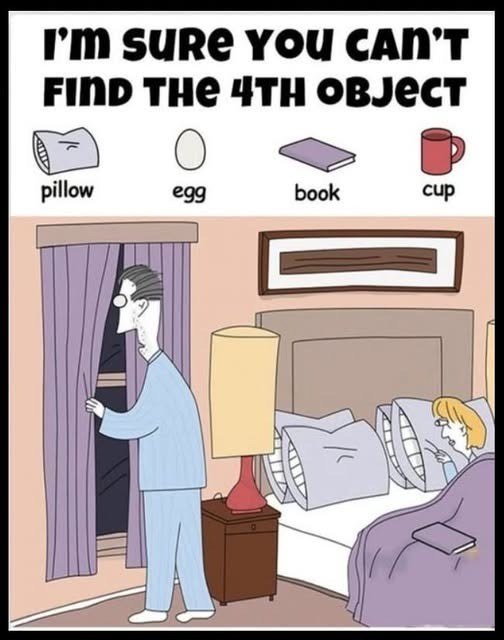At a glance, the cozy bedroom scene looks harmlessly ordinary—a neatly made bed, a soft bedside lamp, shelves dotted with ornaments, maybe a slice of morning light slipping past the curtains. It’s the kind of image your mind labels “familiar” and moves on. But buried in that comforting stillness are four hidden objects—a book, an egg, a cup, and a pillow—just bold enough to exist, yet subtle enough to escape detection. The challenge sounds easy: find them all in under seventeen seconds. Simple… until you try. Most people fail on their first attempt, not because their eyes are weak, but because their brains are efficient to a fault. This viral visual puzzle isn’t just a bit of internet fun—it’s a live demonstration of how your mind edits reality before you’re even aware of it.

When you stare at that bedroom image, your eyes don’t slowly scan every pixel like a camera; instead, your brain jumps, predicts, filters, and fills in the gaps. Psychologists call this “selective attention”—the same process that lets you tune out background chatter in a crowded room or walk home without remembering each step. In this puzzle, that shortcut becomes the trap. Anything that fits your expectations—blankets, frames, shadows, ordinary shapes—gets filed away as “already seen,” and your perception moves on. The egg might be hiding among round light fixtures, the cup pressed against a lamp base, the book disguised as part of a shelf edge or picture frame, the extra pillow swallowed by matching bedding. You’re not missing them because they’re invisible; you’re missing them because your brain decides they’re unimportant, blending them into the background of “what a bedroom should look like.” The result? You scan, you swear you’ve checked everywhere, and yet the objects sit there, smugly obvious once someone points them out.
To beat a puzzle like this, you have to fight your own habits. That means refusing to stare only at the center of the image, where your attention naturally gravitates, and instead deliberately sweeping the edges, corners, and darker patches your brain tends to ignore. Scan in deliberate layers: top third, middle third, bottom third. Look for shapes instead of “things”—curves that don’t match, straight lines that interrupt a pattern, a rectangle where there shouldn’t be one. Take tiny breaks; look away for a few seconds and come back. When you stare too long, your brain literally starts to ignore sections, treating them as static wallpaper. This is also why a second attempt often feels magically easier once you relax. Under time pressure, you rush and rely on rough guesses. When the pressure drops, your perception sharpens. That little rush you feel when you finally spot the egg or the book? That’s a burst of dopamine—your brain’s reward chemical—lighting up, the same system that keeps you hooked on crosswords, Wordle, or Sudoku. Over time, these small moments of victory do more than entertain you; they train your brain to notice patterns, irregularities, and subtle details. Neuroscientists call this pattern recognition, and it’s a skill used everywhere—from art and design to engineering, diagnostics, and even everyday navigation.
Hidden-object puzzles like this one are more than eye games; they’re quiet metaphors for how we move through life. We assume we’re seeing everything, but in reality, we’re filtering ruthlessly—skimming over what feels familiar, overlooking what doesn’t demand our attention, missing the “book, egg, cup, and pillow” sitting in plain sight in our relationships, routines, and surroundings. That’s why optometrists and therapists sometimes use similar visual exercises: they sharpen not only visual tracking but also patience, focus, and the habit of really looking. If you want to get better—at puzzles and at noticing life—practice widening your attention. Tilt your screen, zoom out for contrast, compare what you see with what a friend sees, hunt for tiny imperfections: a misplaced shadow, a too-crisp edge, a color that’s just slightly off. And then try taking that same mindset off the screen—spot the small change in a loved one’s mood, the tiny object out of place on your desk, the detail you normally gloss over on your daily walk. The takeaway is simple and quietly profound: the world is full of things your brain has decided not to show you. A silly bedroom puzzle, with its hidden book, egg, cup, and pillow, is just your invitation to slow down, look again, and prove—even for a moment—that you can outsmart your own mind.
